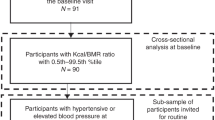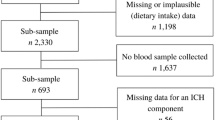Abstract
Objective:
Adolescents are an interesting but neglected target group in obesity prevention. We assessed the feasibility of using a diet optimization approach for computer-tailored nutrition interventions for adolescents.
Method:
Development of an optimization model based on the public health approach to diet optimization. On the basis of food frequency questionnaires (FFQ) of 48 adolescents (14–17 years) optimized diets were calculated.
Results:
The optimization calculations for all cases resulted in individual advice. On a total of 137 items included in the FFQ, the individualized advice included changes in a minimum of 36 and a maximum of 88 items (mean: 61 items), recommendations for changes in the food items ranged from less than 1 g day−1 up to 1660 g day−1. In almost all cases a higher intake of fruit and vegetables was recommended; some unexpected advice was also generated (for example, to decrease the consumption of brown bread and to increase the consumption of pizza). The strengths and weaknesses of the optimized diets are discussed.
Conclusion:
Using the optimization approach is a step forward in nutrition tailoring interventions but the model used in the present feasibility study still needs to be refined.
This is a preview of subscription content, access via your institution
Access options
Subscribe to this journal
Receive 12 print issues and online access
$259.00 per year
only $21.58 per issue
Buy this article
- Purchase on Springer Link
- Instant access to full article PDF
Prices may be subject to local taxes which are calculated during checkout
Similar content being viewed by others
References
Dwyer JT . Diet and nutritional strategies for cancer risk reduction-focus on the 21st century. Cancer 1993; 72: 1024–1031.
Gong E, Heald F . Diet, nutrition and adolescence. In: Shils M, Olsen J, Shike M (eds). Modern Nutrition in Health and Disease. Lea and Febiger: Philadelphia, 1994, pp 7759–7769.
Nicklas TA, Johnson CC, Myers L, Farris RP, Cunningham A . Outcomes of a high school program to increase fruit and vegetable consumption: Gimme 5—a nutrition concept for students. J Sch Health 1998; 68: 248–253.
Lyttle LA, Murray DM, Perry CL, Story M, Birnbaum AS, Kubrik MY et al. School-based approaches to effect adolescents’ diets: results form the TEENS study. Health Educ Behav 2004; 31: 270–287.
Haerens L, De Bourdeaudhuij I, Maes L, Vereecken C, Brug J, Deforche B . The effects of a middle school healthy eating intervention on adolescents’ fat and fruit intake and soft-drink consumption. Public Health Nutr 2007; 10: 443–449.
Kroeze W, Werkman A, Brug J . A systematic review of randomized trials on the effectiveness of computer-tailored education on physical activity and dietary behaviours. Ann Behav Med 2006; 3: 205–223.
De Vries H, Brug J . Computer-tailored interventions motivating people to adopt health promoting behaviours: introduction to a new approach. Patient Educ Couns 1999; 36: 99–135.
Baker LE, Kirschenbaum DS . Self-monitoring may be necessary for successful weight control. Behav Ther 1993; 24: 377–394.
De Bourdeaudhuij I, Brug J, Vandelanotte C, Van Oost P . Differences in impact between a family- versus an individual-based tailored intervention to reduce fat intake. Health Educ Res 2002; 17: 435–449.
Frenn M, Malin S, Brown R, Greer Y, Fox J, Greer J, et al. Changing the tide: an Internet/video exercise and low fat diet intervention with middle school students. Appl Nurs Res 2005; 18: 13–21.
Haerens L, Deforche B, Maes L, Brug J, Vandelanotte C, De Bourdeaudhuij I . A computer tailored fat intake intervention among adolescents: results of a randomised controlled trial. Ann Behav Med 2007; 34: 253–262.
Haerens L, Deforche B, Maes L, Cardon G, Stevens V, De Bourdeaudhuij I . Evaluation of a 2-year physical activity and healthy eating intervention in middle school children. Health Educ Res 2006; 21: 911–921.
Nigg CR, Allegrante JP, Ory M . Theory-comparison and multiple-behaviour research: common themes advancing health behaviour research. Health Educ Res 2002; 17: 670–679.
Schuit AJ, Van Loon JM, Tijhuis M, Ocke MC . Clustering of life style risk factors in a general adult population. Prev Med 2002; 35: 219–224.
Moreno LA, Gonzalez-Gross M, Kersting M, Molnar D, De Henauw S, Beghin L et al., on behalf of the HELENA Study Group. Assessing, understanding and modifying nutritional status, eating habits and physical activity in European adolescents. The HELENA Study. Public Health Nutr 2008; 11: 288–299.
Brug J, Campbell M, van Assema P . The application and impact of computer-generated personalized nutrition education: a review of the literature. Patient Educ Couns 1999; 36: 145–156.
Gedrich K, Hensel A, Binder I, Karg G . How optimal are computer-calculated optimal diets? Eur J Clin Nutr 1999; 53: 309–318.
Vandelanotte C, Matthys C, De Bouredeaudhuij I . Reliability of a computerized questionnaire to measure fat intake in Belgium. Nutr Res 2004; 24: 621–631.
The Federal Food Code and Nutrient Data Base (BLS II.2). Conception, Structure and Documentation of the Data Base Blsdat. BgVV: Berlin, 1998.
NEVO Tabel, Nederlands Voedingsstoffenbestand (Dutch Food Composition Table). NEVO Foundation: Zeist, 2001.
Belgische Voedingsmiddelentabel, tweede uitgave (Belgian Food Composition Table, 4th edn). NUBEL, Ministerie van Volksgezondheid: Brussels, 2004.
Steinel M . Models for determining optimal nutrition in private households. Z Ernahrungswis 1993; 32: 79–92.
Kafatos A, Codrington CA . Nutrition and diet for healthy lifestyles in Europe; the EURODIET project. Public Health Nutr 2001; 4 (S2A): 265–336.
German Nutrition Society, Austrian Nutrition Society, Swiss Society for Nutrition Research, Swiss Nutrition Association. D-A-CH Reference Values for Nutrient Intake. Umschau/Braus: Frankfurt/M, 2002.
WHO. Diet, nutrition and the prevention of chronic diseases. Report of the joint WHO/FAO expert consultation. WHO Technical Report Series, No. 916 (TRS 916), 2003.
Leclercq C, Valsta LM, Turrini A . Food composition issues-implications for the development of food-based dietary guidelines. Public Health Nutr 2001; 4: 677–682.
West CE, van Staveren WA . Food consumption, nutrient intake, and the use of food composition tables. In: Margetts B, Nelson M (eds). Design Concepts in Nutrition Epidemiology, 2nd edn. Oxford University Press: Oxford, 1997, pp 107–122.
FAO/WHO. Preparation and use of Food-Based Dietary Guidelines. Report of a Joint FAO/WHO Consultation, World Health Organisation, Geneva, WHO Technical Report Series 880, 1998.
Food and Agriculture Organization/World Health Organization. Preparation and Use of Food-based Dietary Guidelines. Report of a Joint FAO/WHO Consultation. WHO Technical Report Series no. 880. WHO: Geneva, 1998.
Acknowledgements
The HELENA Study takes place with the financial support of the European Community Sixth RTD Framework Programme (Contract FOOD-CT-2005-007034). The content of this study reflects only the authors’ views and the European Community is not liable for any use that may be made of the information contained therein. Carine Vereecken is postdoctoral researcher funded by the Research Foundation Flanders (FWO).
Author information
Authors and Affiliations
Consortia
Corresponding author
Additional information
Conflict of interest
The authors state no conflict of interest.
Rights and permissions
About this article
Cite this article
Maes, L., Vereecken, C., Gedrich, K. et al. A feasibility study of using a diet optimization approach in a web-based computer-tailoring intervention for adolescents. Int J Obes 32 (Suppl 5), S76–S81 (2008). https://doi.org/10.1038/ijo.2008.186
Published:
Issue Date:
DOI: https://doi.org/10.1038/ijo.2008.186



